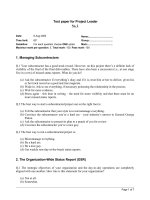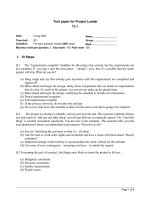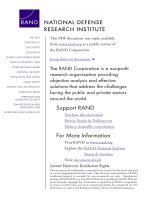Test paper for Project Leader
Bạn đang xem bản rút gọn của tài liệu. Xem và tải ngay bản đầy đủ của tài liệu tại đây (117.78 KB, 7 trang )
Test paper for Project Leader
No. 1
Date: 6 Aug 2005
Name:....................................
Time limit: 60’ Group:...................................
Guideline: For each question choose ONE option
Mark:......................................
Maximun mark per question: 5, Total mark: 150, Pass mark: 100
1. 10 Steps
Q.1 The “requirements complete” deadline for the project has arrived, but the requirements are not
complete. If you don’t start the next phase – “design”- now, then it’s possible that the entire project
will slip. What do you do?
(a) Hang tough and say that nobody goes anywhere until the requirements are completed and
signed off.
(b) Blaze ahead and begin the design, doing those components that are based on requirements that
do exist. It’s early in the project- you can always make up the ground later.
(c) Blaze ahead and begin the design, modifying the schedule to include two milestones;
(d) Partial requirements complete;
(e) Full requirements complete
(f) In the process, however, do not alter the end date
(g) Do as in (c) but move the end date to allow for the extra work that is going to be required
Q.2 The project is running to schedule, and you are near the end. The customer suddenly phones
you and wants to “add just one little thing” and still get delivery as originally agreed. The “one little
thing” is actually reasonably significant. You are new to the company. The customer tells you that
your predecessor always accommodated such requests. What do you do?
(a) Say yes. Satisfying the customer is what it’s all about
(b) Ask the team to work some nights and weekends and have a moan with them about “bloody
customers”.
(c) Implement change control and try to accommodate the client’s desire for the end date
(d) Use some of your contingency – assuming you have – to satisfy the request.
Q.3 In scoping the goal of a project, the things most likely to cause the project to fail are:
(a) Budgetary constraints.
(b) Resource constraints.
(c) Quality requirements.
(d) People issues.
Page 1 of 7
2. Scoping Projects and making Plans
Q.1 Estimate the task “review document.” The document is 30 pages, printed on one side- all text and
no diagrams. There are three reviewers.
(a) 1 hour
(b) 3* 1.5 person- hours
(c) One day elapsed to get it all sorted
(d) None of the above.
Q.2 You are a project manager and you are assigned to run IT project. You have never before run an
IT project. When you go to build the plan, the techies tell you that there is no way that they can
estimate this project. “It’ll take as long as it takes” Do you:
(a) Accept this
(b) Sign up for a night course in IT and start spending all your weekends in libraries and
bookstores.
(c) Insist that the project be estimated, making assumptions where necessary
(d) Ask to be reassigned to a project in the discipline(s) in which you are proficient.
Q.3 When estimating, who should produce the estimates?
(a) The people who are going to do the work
(b) The project manager on his or her own.
(c) The stakeholders.
(d) The project management department.
3. Running projects
Q.1 You are a consultant running a project for a client. Jobs that are in the project plan and that have
to be done by the client’s people are continuously late or done badly. Who responsibility in this?
(a) Yours personally.
(b) Your company’s
(c) The client’s people’s
(d) The client’s management
Q.2 You are the project manager of a technical project, and you also have technical jobs to do on the
project. The result is that you’re insanely busy with never enough time for everything. If you can only
pick one thing to do, do you choose:
(a) The technical jobs- on the basis that if these are not done, the project won’t get done.
(b) Ask for an “admin. Person” to “update the plan” while you concentrate on the technical work.
(c) The project management jobs
(d) None of the above
Page 2 of 7
Q.3 Part of your project has been subcontracted to another organization. The separation is very clear,
and the interface between the two pieces of the project is carefully defined. You’re paying them a fat
fee for the project management of their bit. You have no visibility of the progress of the subcontracted
part, and you’re starting to get a feeling that all is not well. What do you do?
(a) Get some evidence to support you hunch: then, wade in there and sort it out
(b) Take the view that you’re paying for project management – it’s their problem.
(c) As in (b) but take the additional precaution of writing a “ cover- your- ass” memo pointing
this out to every body.
(d) Take no action until the excrement hits the ventilating device and then do (a)
4. Assessing Project Plans
Q.1 You are running a project, and you finally come to the conclusion that J. Smith, who works for
you, definitely isn’t up to the piece of the project he or she has been given. You’re decided to remove
him or her from the project. Assuming you carry through his decision, what’s going to be your
immediate priority?
(a) The impact on J. Smith’s state of mind, aspiration, career, morale, etc.
(b) How you stand legally having removed him or her
(c) Whether your boss will back you in your action.
(d) Finding somebody else to do J. Smith’s jobs
Q.2 You have a superstar working on your project. He or she is highly skilled, experienced, and
motivated – and doing what he or she loves to do. What is most likely to make such superstars
unhappy?
(a) You micromanaging them
(b) Being given uninteresting work
(c) You questioning their judgment and decisions
(d) Low or infrequent salary hikes
Q.3 Most of the people who work on projects are neither the duds described in question 1 nor the
geniuses of question 2 . To keep these people motivated, which of the following would be best?
(a) Social events – barbecues, parties, and so on.
(b) Involving them in the planning
(c) Ensuring that, via status reporting and other communication, they stay informed about the big
picture, their part in it, and progress on the project.
(d) Freebies – T-shirts, mugs, that sort of thing, to foster a team spirit.
5 Assessing Projects
Q.1 You’ve inherited a project and having assessed it using steps 1-5, notice that in doing this, you
weren’t automatically accepting the previous project manager’s “baggage” – you’ve discovered that it
looks like it will be ending three months ahead of the previously published schedule. What do you do
next?
Page 3 of 7
(a) Tell the team
(b) Say nothing
(c) Tell all the stakeholders
(d) None of the above
Q.2 You work in an organization where, if they see contingency in a plan, they take it out. ( No, I’m
sure you couldn’t imagine such a place!) Putting hidden contingency into your plan is morally
justifiable thing to do.
(a) Yes.
(b) No.
(c) Not sure
(d) I’d put it in explicitly and defined it to the death
Q.3 Assuming you have no estimating data from completed projects to go by, when putting
contingency your plan, which of these would be the best approach
(a) Two percent
(b) Ten percent
(c) Fifteen percent.
(d) As much as you can possibly get away with
6. Rescuing projects: Rescuing = Assessing + Scoping and Planning
Q1: A trainee has joined your project team. What is the best leadership style to use?
(a) Leave ‘em to it and see whether they sink or swim.
(b) Micromanagement.
(c) Ash another member of the team to take the rookie under his or her wing.
(d) Not your problem. Ask personnel to provide a training plan, and until the new recruit is “up to
seed” it’ s personnel’s problem
Q2: You’ve got a superstar on your project – highly skilled, experienced, motivated, as described
earlier in this book. You try to spend a chunk of time every day with him or her. You rationale is that:
(a) Your spending time with this person inspire him or her and squeezes all the available
“superstardom” out or him or her.
(b) Your spending time with him or her serves to advance the project.
(c) You like being with him or her because you can have interesting discussions on the industry
area in which you’re both involved.
(d) You’ve nothing better to do.
Q3: Your project has 10 people working on it full time and will run for a year. It has a flat
organization structure (i.e., all 10 people report directly to you). How much project management
effort will this require from you?
(a) It’s a full-time job.
Page 4 of 7
(b) You could run two of these.
(c) You have two and a half days a week available to do jobs on the project.
(d) You have four days a week available to do jobs on the project.
7. Auditing completed projects.
Q1: Assuming that you use your project plan as your road map through the project, how often should
you update it?
(a) Every day.
(b) Constantly.
(c) Once a week.
(d) Not at all. Now that the powers-that-be—the management, customer, standards people—have
approved the plan, the real fun starts.
Q2: You get a monumental (bad, needless to add) surprise on your project. What do you do?
(a) Punish the perpetrator.
(b) Point out to the perpetrator the impact of what he or she has done, help him or her to put a
plan in place to fix the problem, and micromanage him or her out of it.
(c) Do nothing to the perpetrator. It’s your job as manager to deal with these things.
(d) Vow to put more contingency in the plan next time.
Q3: Things are going swimmingly on your project. You’ve never seen a plan come together so well
before. There are only a few weeks left. You think you’ll fit in a week-earned vacation. What do you
do next?
(e) Call your travel agent and book it.
(f) Forget the whole idea
(g) Do (a) plus nominate a member of team as your deputy while you’re gone.
(h) Book it for when the project ends
8. Running multiple projects
Q1: You are a project management consultant called in to do a rescue. The project is many months
past its delivery date and still going strong, burning up money like there’s no tomorrow. The project
has all sorts of specs and other documentation, a harassed project manager sweating over a vast Gant
chart, people working all the hours God sends, meetings, status reports, and all the other paraphernalia
of a project. It’s like ancient Egypt during the construction of the great pyramid of Cheops. You do a
quick PSI calculation and come out with a 25. How is this possible, given that, this late in the project,
You’d expect it to be much higher?
(a) It’s a trick question, and I’ve fed you misinformation.
(b) The people are working overtime.
(c) There is no change control.
(d) The status reporting is inadequate.
Page 5 of 7









